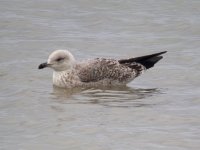lou salomon
the birdonist
What do you me about this Gull?
Photographed today by a friend of me on the german baltic coast.
hallo armin,
that's quite a typical herring gull, possibly of more northern or eastern origin and having consumed some food containing lots of carotenoids, thus its yellowish bill base and legs which otherwise would be pinkish. kent olsen from denmark just recently observed a similar phenomenon (young danish and southern swedish birds with yellowish bare parts): http://gulldk.blogspot.com/2011/12/herring-gull-larus-argentatus-with.html and http://www.talk.gull-research.org/viewtopic.php?f=3&t=637&hilit=kent
cheers from stuttgart,
Last edited:





